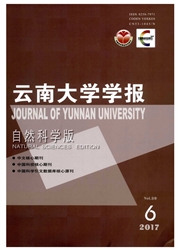

 中文摘要:
中文摘要:
应用标准化均方根误差和相关性,分析3种再分析资料在西双版纳地区的适用性.通过相减法(Ob-servation minus Reanalysis,简称OMR)探讨西双版纳土地利用/覆盖变化对气温的影响,结果表明:NCEP-1、NECP-2和ERA-40数据及其距平值和实际观测气温的相关性均达到极显著水平(P〈0.01),均方根误差总体小于1,ERA-40的可信度最高.研究区4个气象站(勐海、景洪、勐仑和勐腊)月平均气温和再分析气温均呈上升趋势.剧烈的土地利用变化显著影响了平均气温变化,对景洪站、勐腊站、勐仑站和勐海站平均气温变化贡献值分别为0.08、0.07、0.01、0.05℃/10 a.景洪气象站气温变化受土地利用变化影响最明显.不同年代观测气温和再分析资料差值得到,20世纪80年代土地利用变化对气温影响最大,贡献值为0.09℃.有林地、灌木林地、水田面积的减少,橡胶园和建设用地面积的增加影响了气温变化.
 英文摘要:
英文摘要:
This article investigated the influence of land use/land cover change(LUCC) on temperature.By means of Pearson correlation and normalized root mean square error(RMSE),the reliability of the three kinds of reanalysis data used in Xishuangbanna was studied.The contribution that LUCC made to temperature was obtained from subtracting the reanalysis from the observed data(observation minus reanalysis,OMR).The results showed that ERA-40 was most reliable.The correlation between three kinds of reanalysis data NCEP-1,NCEP-2 and ERA-40,and observed data exceeded level 1%(P0.01).The RMSE was less than 1 in general.Among four weather stations(Menghai,Jinghong,Menglun,Mengla),both observed and reanalysis data had remarkable warming trends,but the speed of reanalysis was smaller than the observed.The terrible change of land covers had caused impacts on temperature.The OMR results showed land cover change around Jinghong station had contributed 0.084 ℃/10 a to temperature warming,0.072 ℃/10 a and 0.012 ℃/10 a to Mengla and Menglun respectively.Temperature of Menghai station seemed little affected by LUCC.Temperature of Jinghong station was most sensitive to LUCC.The OMR of decades indicated that LUCC during 1980s caused 0.09 ℃ warming.All of these mainly due to the decrease of forest,shrubland and paddy land.Besides,the extension of rubber plantation and built-up was also the cause of warming.
 同期刊论文项目
同期刊论文项目
 同项目期刊论文
同项目期刊论文
 Soil Changes Induced by Rubber and Tea Plantation Establishment: Comparison with Tropical Rain Fores
Soil Changes Induced by Rubber and Tea Plantation Establishment: Comparison with Tropical Rain Fores Dry-season water utilization by trees growing on thin karst soil in a seasonal tropical rainforest o
Dry-season water utilization by trees growing on thin karst soil in a seasonal tropical rainforest o The effects of conversion of tropical rainforest to rubber plantation on splash erosion in Xishuangb
The effects of conversion of tropical rainforest to rubber plantation on splash erosion in Xishuangb 期刊信息
期刊信息
